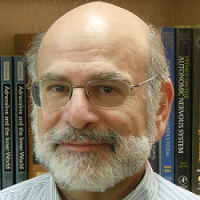
BG 10 RM 8N260
10 CENTER DR
BETHESDA MD 20814
Dr. David S. Goldstein is a founder and thought leader in autonomic medicine, with substantial experience and expertise in clinical catecholamine neurochemistry, sympathetic neuroimaging, autonomic pathophysiology, mechanisms of catecholaminergic neurodegeneration, and stress and homeostasis as medical scientific ideas. He received his BA from Yale College and M.D.-Ph.D. in Behavioral Sciences from Johns Hopkins. After internal medical residency at the University of Washington he came to the NIH as a Clinical Associate in the NHLBI in 1978, obtaining tenure as a Senior Investigator in 1984. He joined the NINDS in 1990 to head the Clinical Neurochemistry Section and founded the Clinical Neurocardiology Section (name changed to Autonomic Medicine Section in 2019). He has received Yale's Angier Prize for Research in Psychology, the Distinguished Investigator Award of the Society for Clinical and Translational Science, the NIH Distinguished Clinical Teacher Award, the Schatz Award of the American Academy of Neurology for research on autonomic disorders, and 2 NINDS Director’s Awards for mentorship. He is a Fellow of the American Heart Association and the American Autonomic Society and a member of the Association of American Physicians. Additionally, he directs the UCNS-accredited Clinical Fellowship in Autonomic Disorders at the NIH Clinical Center.
Dr. Goldstein is the author of more than 650 research articles and several books, including "Adrenaline and the Inner World: An Introduction to Scientific Integrative Medicine," ”Dysautonomias: A Handbook for Patients,” "Stress, Catecholamines, and Cardiovascular Disease," "The Autonomic Nervous System in Health and Disease,” and the e-books, "Principles of Autonomic Medicine" and “Autonomic Medicine for Students.” His strategic goals are to establish autonomic medicine as a clinical and scientific discipline, promote patient-oriented research on autonomic and catecholamine-related disorders, and mentor rising investigators in the field.
Research of the Autonomic Medicine Section (AMS) focuses on autonomic and catecholamine-related disorders, using a mainly patient-oriented approach. In the recently completed prospective longitudinal PDRisk study we found that cardiac norepinephrine deficiency revealed by 18F-dopamine positron emission tomography identifies preclinical central Lewy body diseases (LBDs) in at-risk individuals. We we are combining clinical catecholamine neurochemistry, 18F-dopamine sympathetic neuroimaging, and quantitative immunofluorescence microscopy to distinguish among chronic autonomic failure syndromes; we are conducting a natural history study to test the hypothesis that the Lewy body form of neurogenic orthostatic hypotension (nOH) may evolve into PD+nOH or dementia with Lewy bodies+nOH; and we are applying cerebrospinal fluid catecholamine neurochemistry and multi-tracer central and peripheral neuroimaging to identify dysfunctional but extant catecholaminergic neurons—the “sick-but-not-dead” phenomenon.
We recently successfully applied a computational modeling approach, based on homeostasis and the catecholamine autotoxicity theory, to predict the progression of catecholaminergic neurodegeneration in LBDs. Application of recently identified biomarkers of preclinical central LBDs, coupled with treatments targeting autotoxic catecholaldehydes (obligate intermediates in neuronal catecholamine metabolism), could test for the first time whether one can delay the onset and shorten the duration of symptomatic central LBDs.
Clinical Protocol:
- 18N0140: Clinical Laboratory Evaluation of Chronic Autonomic Failure
- 000490: Mechanisms of Autonomic and Catecholamine-Related Disorders
1. Goldstein DS (2024)
Autonomic Medicine for Students(pdf, 5491 KB) (Export to PDF file)
2. Goldstein DS, Holmes C, Sullivan P, Lopez G, Gelsomino J, Moore S, Isonaka R, Wu T, Sharabi Y (2023)
Cardiac noradrenergic deficiency revealed by 18F-dopamine positron emission tomography identifies preclinical central Lewy body diseases.
J Clin Invest 2023;Oct 26:e172460. doi: 10.1172/JCI172460. (PMID 37883190)
3. Goldstein DS (2022)
Principles of Autonomic Medicine (Export to ZIP file)
4. Goldstein DS (2019)
How does homeostasis happen? Integrative physiologic, systems biologic, and evolutionary perspectives
Am J Physiol (Regul Integr Comp Physiol), 316, R301-R317.(PMID 28918243)
5. Goldstein DS, Pekker M, Eisenhofer G, Sharabi Y. (2019)
Computational modeling reveals multiple abnormalities of myocardial noradrenergic function in Lewy body diseases
JCI Insight , doi: 10.1172/jci.insight.130441, (PMID 31335324)
6. Isonaka R, Rosenberg AZ, Sullivan P, Corrales A, Holmes C, Sharabi Y, Goldstein DS (2019)
Alpha-synuclein deposition within sympathetic noradrenergic neurons is associated with myocardial noradrenergic deficiency in neurogenic orthostatic hypotension.
Hypertension 73, 910-918. (PMID 30798661)
7. Goldstein DS, Sullivan P, Holmes C, Mash DC, Kopin IJ, Sharabi Y (2017)
Determinants of denervation-independent depletion of putamen dopamine in Parkinson's disease and multiple system atrophy.
Park Rel Dis 35, 88-91. (PMID 28034624)
8. Goldstein DS, Holmes C, Sharabi Y, Wu T (2015)
Survival in synucleinopathies: A prospective cohort study.
Neurology 85, 1554-1561. (PMID 26432848)
9. Goldstein DS. (2013)
Concepts of scientific integrative medicine applied to the physiology and pathophysiology of catecholamine systems.
Compr Physiol, 3, 1569-1610. (PMID 24265239).
10. Goldstein DS, Sullivan P, Holmes C, Miller GW, Alter S, Strong G, Mash DC, Kopin IJ, Sharabi Y. (2013)
Determinants of buildup of the toxic dopamine metabolite DOPAL in Parkinson disease.
J Neurochem, 123, 591-603. (PMID: 23786406).
11. Goldstein DS. (2006)
Adrenaline and the Inner World: An Introduction to Scientific Integrative Medicine
Johns Hopkins University Press
12. Eisenhofer G, Kopin IJ, Goldstein DS. (2004)
Catecholamine Metabolism: A Contemporary View with Implications for Physiology and Medicine
Pharmacol Rev, 56, 331-349
13. Goldstein DS, Eisenhofer G, Kopin IJ. (2003)
Sources and significance of plasma levels of catechols and their metabolites in humans
J Pharmacol Exp Ther, 305, 800-811
14. Goldstein DS, Katzper M, Linares O, Kopin IJ (2002)
Kinetic model for the fate of the sympathoneural imaging agent 6-[18F]fluorodopamine in the human heart: A novel means to assess cardiac sympathetic neuronal function.
Naunyn-Schmiedeberg’s Arch Pharmacol 365, 38-49 (PMID 11862332)
15. Goldstein DS (2001)
The Autonomic Nervous System in Health and Disease
Taylor & Francis
16. Goldstein DS, Holmes C, Li S-T, Bruce S, Metman LV, Cannon RO III (2000)
Cardiac sympathetic denervation in Parkinson disease.
Ann Intern Med 133, 338-347. (PMID 10979878)
17. Goldstein DS, Holmes C, Cannon RO III, Eisenhofer G, Kopin IJ (1997)
Sympathetic cardioneuropathy in dysautonomias
N Engl J Med, 336, 696-702
